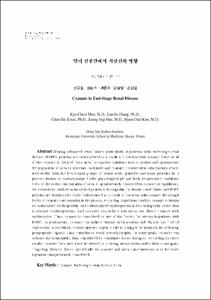말기 신부전에서 시안산의 영향
- Alternative Author(s)
- Mun, Kyo Cheol; Kwak, Chun Sik; Han, Seung Yeup; Kim, Hyun Chul
- Journal Title
- Keimyung Medical Journal
- Issued Date
- 2005
- Keyword
- Cyanate; End-stage renal disease; Urea
- Abstract
- During advanced renal failure, particularly in patients with end-stage renal disease (ESRD), proteins are carbamylated as a result of a reaction with cyanate. Some or all of the cyanate is derived from urea. In aqueous solution there is partial and spontaneous decomposition of urea to ammonia, carbonate and cyanate. Cyanate then subsequently reacts irreversibly with the N-terminal groups of amino acids, peptides and many proteins by a process known as carbamylation. Under physiological pH and body temperature conditions 0.8% of the molar concentration of urea is spontaneously converted to cyanate at equilibrium. An extensively studied carbamylated protein is hemoglobin. In chronic renal failure and ESRD proteins are known to be easily carbamylated as a result of reactions with cyanate due to high levels of cyanate concentration in the plasma. According to previous studies, cyanate is known to carbamylate erythropoietin, and carbamylated erythropoietin is less biologically active than is normal erythropoietin. And cyanate can induce hemolysis via direct contact with erythrocytes. Thus, cyanate is considered as one of the factors for anemia in patients with ESRD. In peritoneum, cyanate can induce chronic inflammation and fibrosis via TCF-β expression. In osteoblast, cyanate appears to play a role as a trigger for apoptosis by activating proapoptotic signals, thus contributes renal osteodystrophy. In neutrophils, cyanate can activate the neutrophils, thus considered to contribute tissue damages. According to these results, cyanate form urea must be viewed as a strong uremic toxin, rather than a surrogate. Targeting dialysis doses specifically to cyanate and urea concentrations may be more important than previously considered.
- Alternative Title
- Cyanate in End-Stage Renal Disease
- Publisher
- Keimyung University School of Medicine
- Citation
- 문교철 et al. (2005). 말기 신부전에서 시안산의 영향. Keimyung Medical Journal, 24(2), 120–126.
- Type
- Article
- 파일 목록
-
-
Download
 24-120.pdf
기타 데이터 / 351.1 kB / Adobe PDF
24-120.pdf
기타 데이터 / 351.1 kB / Adobe PDF
-
Items in Repository are protected by copyright, with all rights reserved, unless otherwise indicated.